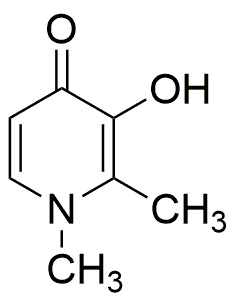3-Hydroxy-1,2-dimethyl-4(1H)-pyridone is widely utilized in research focused on:
- Pharmaceutical Development: This compound serves as a key intermediate in the synthesis of various pharmaceuticals, particularly those targeting neurological disorders, due to its ability to interact with specific receptors in the brain.
- Agricultural Chemistry: It is used in the formulation of agrochemicals, acting as a plant growth regulator that enhances crop yield and resilience against pests, making it valuable for sustainable agriculture.
- Analytical Chemistry: The compound is employed as a reagent in analytical methods for detecting metal ions, providing a reliable way to assess soil and water quality, which is crucial for environmental monitoring.
- Material Science: It finds applications in the development of advanced materials, particularly in creating polymers with enhanced thermal stability and mechanical properties, beneficial for various industrial applications.
- Biochemical Research: Researchers utilize this compound in studies related to enzyme inhibition and metabolic pathways, aiding in the understanding of biochemical processes and the development of new therapeutic strategies.
General Information
Properties
Safety and Regulations
Applications
3-Hydroxy-1,2-dimethyl-4(1H)-pyridone is widely utilized in research focused on:
- Pharmaceutical Development: This compound serves as a key intermediate in the synthesis of various pharmaceuticals, particularly those targeting neurological disorders, due to its ability to interact with specific receptors in the brain.
- Agricultural Chemistry: It is used in the formulation of agrochemicals, acting as a plant growth regulator that enhances crop yield and resilience against pests, making it valuable for sustainable agriculture.
- Analytical Chemistry: The compound is employed as a reagent in analytical methods for detecting metal ions, providing a reliable way to assess soil and water quality, which is crucial for environmental monitoring.
- Material Science: It finds applications in the development of advanced materials, particularly in creating polymers with enhanced thermal stability and mechanical properties, beneficial for various industrial applications.
- Biochemical Research: Researchers utilize this compound in studies related to enzyme inhibition and metabolic pathways, aiding in the understanding of biochemical processes and the development of new therapeutic strategies.
Documents
Safety Data Sheets (SDS)
The SDS provides comprehensive safety information on handling, storage, and disposal of the product.
Product Specification (PS)
The PS provides a comprehensive breakdown of the product’s properties, including chemical composition, physical state, purity, and storage requirements. It also details acceptable quality ranges and the product's intended applications.
Certificates of Analysis (COA)
Search for Certificates of Analysis (COA) by entering the products Lot Number. Lot and Batch Numbers can be found on a product’s label following the words ‘Lot’ or ‘Batch’.
*Catalog Number
*Lot Number
Certificates Of Origin (COO)
This COO confirms the country where the product was manufactured, and also details the materials and components used in it and whether it is derived from natural, synthetic, or other specific sources. This certificate may be required for customs, trade, and regulatory compliance.
*Catalog Number
*Lot Number
Safety Data Sheets (SDS)
The SDS provides comprehensive safety information on handling, storage, and disposal of the product.
DownloadProduct Specification (PS)
The PS provides a comprehensive breakdown of the product’s properties, including chemical composition, physical state, purity, and storage requirements. It also details acceptable quality ranges and the product's intended applications.
DownloadCertificates of Analysis (COA)
Search for Certificates of Analysis (COA) by entering the products Lot Number. Lot and Batch Numbers can be found on a product’s label following the words ‘Lot’ or ‘Batch’.
*Catalog Number
*Lot Number
Certificates Of Origin (COO)
This COO confirms the country where the product was manufactured, and also details the materials and components used in it and whether it is derived from natural, synthetic, or other specific sources. This certificate may be required for customs, trade, and regulatory compliance.


